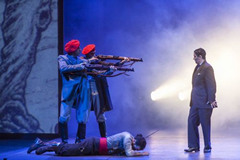| Opera Reviews | 13 May 2024 |
A visually and aurally stunning experienceby Steve Cohen |
|
| Golijov: Ainadamar Opera Philadelphia February 2014 |
|
|
Golijov’s music reflects his own mix of Eastern-European Jewish, Latin-American and gypsy heritages, and perfectly suits the history of the Iberian peninsula, where Catholic, Jewish and Muslim cultures productively intermixed in the Middle Ages. As he tells the story of Spanish poet and playwright Federico Garcia Lorca, Golijov’s music also conjures universal relevance to today’s problems in the Middle East. His orchestra includes guitars and exotic percussion (including cajóns, congas and maracas) and players in the pit contribute hand-clapping. In addition, Golijov unfurls percussive stage business and electronic audio effects. Echoes of gurgling water and galloping hoof beats are transformed into heel-clicking rhythms. When Lorca and two other prisoners are executed, gunshots repeat in a flamenco pattern which segues into a soulful and primal canto. Lorca seems like an ideal character for a musical play. He was an Andalusian who loved bullfighting, played the guitar and sang gypsy songs. He had a charismatic personality as he championed the cause of working people and especially of women. In addition, he was a poet who fused musical elements into his writing. In one great example of his imagery he compared the crescent moon to a fermata, a held note interrupting the harmony of the night. But the Lorca in the libretto by David Henry Hwang does not display those exciting qualities. Instead, he is an idealized, almost-Christ-like figure. Writing his role for a woman singer seems like an additional way of avoiding Lorca’s sexuality. "All his poetry turns around frustrated love,” wrote Lorca’s biographer Ian Gibson, and “his tormented characters who can't live the life they want.” Homophobia existed in Spain on both sides in the civil war and afterwards, and Lorca’s family did not want the subject to be discussed. It’s a shame that in the 21st century Hwang still felt the topic to be off limits, and he ignores that aspect of Lorca. British writer Philippa Goslett says that Lorca had a gay relationship with his scenic designer, Salvador Dali, and as a substitute for completing their union, Lorca slept with a female friend with Dali present as a voyeur. Now that’s further than I’d want this, or any opera, to go— but I do wish Hwang had been less ethereal in his approach. Neither did Hwang show what chemistry drew Lorca and Xirgu together. The audience is just asked to accept that there’s a personal bond, and that Xirgu became his disciple. Lorca was a supporter of the Spanish Republic that won election in 1931. The government was anti-clerical and favored labor unions and greater rights for minority groups and the poor. Many Spaniards were not ready for such changes to their traditional, church-dominated society. Military forces led by Francisco Franco, supported by the Catholic Church and by Hitler, overthrew the Republic, which was defended by communists sent by the Soviet Union and by idealistic American volunteers. Ainadamar (“Fountain of Tears” in Arabic) is a place near Granada where the poet was assassinated. The Santa Fe production, directed by Peter Sellars in 2005, emphasized the arid aspect of Depression-era Spain and showed a fountain in the middle of a dry courtyard. The terrain was parched and hard, reflected in colorful tiles painted by the artist known as Gronk. This new production shows Granada as a city at the confluence of four rivers, and we see small boats bobbing on the water. Maria Hinojoso Montenegro as Xirgu sounded darker and tougher than the sweeter-voiced originator of the role, Dawn Upshaw, yet she floated ethereal soft high notes. Mezzo-soprano Marina Pardo in the trouser role of Lorca came across authentically. Soprano Sarah Shafer, as Xirgu’s protégé, displayed a bright soprano voice with a wide vibrato that occasionally overwhelmed the musical line. Corrado Rovaris clearly loves this music and has conducted it at Curtis Institute and in Spain leading up to this sensitive reading. |
|
| Text ©
Steve Cohen Photo © Kelly & Massa |

 Ainadamar is a visually and aurally stunning experience, with dream-like video projections and steamy flamenco dancing. The music and the visuals of this opera are mesmerizing, and this production blended them more effectively than any previous Ainadamar that I’ve attended.
Ainadamar is a visually and aurally stunning experience, with dream-like video projections and steamy flamenco dancing. The music and the visuals of this opera are mesmerizing, and this production blended them more effectively than any previous Ainadamar that I’ve attended. 





